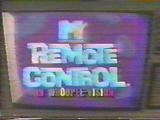Remote Control
From RulesWiki
| This rulesheet needs more screencaps. If you can produce screenshots for this show's rulesheet, please upload them and incorporate them into the rulesheet. |
Contents |
Gameplay
Front Game
Three players, usually of college age, competed. In each round, players used a remote control to select one of nine "channels" from a large console TV, with each channel representing a category of questions often based on television. Most categories consisted of three questions worth 5, 10, and 15 points; others were one-shot categories which were exhausted after just one play, and in some cases penalties (in the form of the "Home Shopping Channel") which deducted from the score of the player who selected it. After each correct answer, the player had the choice to change the channel or stay on the same one.
Point values doubled in the second round. Starting with season 2, at the end of the round, the player with the lowest score was sent "Off the Air", which typically meant being physically removed from the stage whilst still seated in their recliner. A speed-round was then played between the two remaining competitors; whoever amassed the most points was declared the winner (and the loser was evicted in a similar manner as before).
During the show's syndicated run and final season, speed rounds were played at the conclusion of each of the first two rounds, and the final round featured a TV-themed math problem which contestants wagered a portion of their score on solving.
End Game Rules
MTV version
The winner was strapped into a Craftmatic adjustable bed and faced a monolith of nine television screens, each playing a different music video by a different artist (some screens were distorted and some were tilted or upside down). Each time one of the artists was correctly identified, the player received an increasingly valuable prize. Identifying all nine artists in 30 seconds or less won the grand prize, usually a trip.
During the show's final season, the nine video monitors were placed around the syndicated "Wheel of Jeopardy". While strapped to the wheel as it spun, the player had 40 seconds to identify the nine video artists.
Syndicated version, "the Wheel of Jeopardy"
The winner was strapped to a spinning carnival wheel, divided into ten sections with a numbered TV monitor on each end, and was asked ten questions on a particular subject. Each question would be played for an increasingly valuable prize and would change the corresponding monitor to "Grand Prize" if answered correctly. After ten questions, the wheel would slow to a halt, and landing on a "Grand Prize" monitor won the grand prize.
Notes
- The show was set in the fictional basement of Ken's house (located at the fictional address of 72 Whooping Cough Lane), where he supposedly lived with his mother.
- The end of the first round was deemed "snack time", at which point a light snack was furnished to the players.
- SNL performers Adam Sandler and Colin Quinn both had their first major television exposure on this show. Sandler would often appear as the basis to various character-driven categories (such as someone who would laugh the theme songs to various shows), while the gravelly-voiced Quinn ironically served as the show's main announcer.


